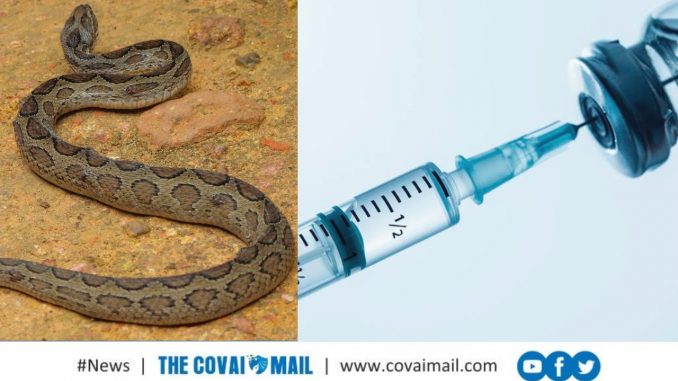
Teeming with diverse habitats, the vast land of India is home to a myriad of diverse plants and animals. Slithering amongst them are about 300 species of snakes, including over 60 venomous species that frequently devastate lives of numerous people with dreadful venomous bites. Each year, around 50,000 people die and approximately 250,000 suffer from some form of permanent disabilities (frequently lose their limbs) due to snakebites in India. The terrifying ‘Big Four’ snakes cause most of these fatalities and disabilities – the Indian cobra, Russell’s viper, Common krait and Saw-scaled viper.

The number of snakebite-induced deaths in India accounts for around 5% of the total injury-related deaths in the country and at least 36% of the total deaths due to snakebites in the world, emphasizing the severity of this challenge. As most of the snakebites occur in remote rural areas of the country, people living in poverty are the most common victims of this threat. Many of these people die as they adhere to myths sewn around snakes and snakebites, and frequently seek easily/cheaply available traditional treatments. Yet there are also many victims who seek medical aid at the local primary health centers, and still lose their lives or limbs, as these medical facilities remain largely unequipped with adequate quantities of antivenoms and essential lifesaving medical equipment. Notably, the high treatment cost in private hospitals prohibits many people from seeking this expensive treatment from them. The lack of essential public awareness about snakes and snakebites is another critical factor that augments the snakebite-induced complications.
Even though snakebite envenoming is a global problem, it has suffered serious negligence in the past decades. Its recent re-instatement as one of the most Neglected Tropical Diseases by the World Health Organization (WHO) will hopefully help bring the much-needed attention to this challenge.
Curse of Vicious Venoms
Snakes are widely feared animals, but not all species are dangerous. Only around 15% of snake species are in fact venomous. So, what makes their venoms so vicious? Venoms are a blend of many harmful proteins and peptides, commonly known as ‘toxins’. These toxins, when injected, can dramatically affect normal biological functions of victims or prey, often causing fatal symptoms. Venom compositions vary from species to species and even based on the geographical regions where they live, thus explaining the diverse clinical symptoms caused by different snakes.
For instance, the venom of Indian cobra causes severe respiratory paralysis making it difficult for the victim to breathe. The victim may also suffer from tremendous pain around the bite site. Contrarily, the nocturnal common krait, which often bites people while they are asleep, causes little to no pain to its victims. As the painless bite goes unnoticed, the venom gets enough time to spread through the body. It causes the facial muscles to tighten, inability to see, speak or breathe, and death if left untreated.
Vipers carry a different skillset to maim their targets. Both Russell’s and Saw-scaled vipers induce several complications in the blood such as bleeding and random blood clotting. The bite from Russell’s viper can also induce kidney failure and severe muscle damage which often results in permanent disabilities. Unable to afford a dialysis treatment or in some serious cases, kidney transplantation, the victims from poor strata often face death when bitten by these snakes. Moreover, victims of Saw-scaled vipers also develop blisters on their skin and mucosal tissue, making their gums and nose bleed.
Ancient Antivenoms Still in Use
Far from ideal, the current antivenoms in the market are the only option available for the snakebite victims. Using an age-old and laborious production process, these antivenoms are produced by injecting small doses of snake venom(s) into a production animal, typically a horse. After repeated injections, the animal builds up an immune response, which results in generation of antibodies against venom toxins. Blood is then drawn from the animal and processed to isolate these antibodies. However, majority of these antibodies do not target venom toxins but may instead target other immunogens that the horse has encountered during its life. This results in high doses of antivenom being needed to treat snakebites.
Based on the types (either one or multiple) of venoms injected into the horse, the antivenom can either neutralize venom from one (monovalent) or multiple (polyvalent) species of snakes. In India, antivenoms are manufactured to be polyvalent by injecting the production animal with the venom of the Big Four snakes. While these antivenoms are largely effective in neutralizing venoms, their animal-based nature coupled with the high doses needed to treat a snakebite often provoke immunological reactions in victims, including serum sickness and anaphylaxis. In rare cases, severe anaphylactic reactions can even result in death of the victim. Moreover, the Big Four targeting antivenoms fail to cover many other venomous snakes that also cause deaths and disabilities in the country.
What’s Brewing in Antivenom Research?
Despite the rapid growth of biotechnology, antivenoms have enjoyed only a little progress. Thankfully, the drawbacks of current antivenoms have been acknowledged. Today several researchers around the world are working on developing better antivenoms.
One of the strategies being pursued employs the Noble Prize-winning invention of “antibody phage display technology”, which can be used to discover fully human antibodies against snake venom toxins. Phage display technology essentially simulates the immune system in a test tube. Genetic codes of billions of human antibodies are packed inside phages (bacteriophages), such that each phage carries the genetic code of a single antibody and thus displays only one antibody on its surface. These antibody displaying phages are then exposed to a target (in this case venom toxins), conceptually similar to how shoals of fish (antibodies) in a lake would be exposed to a fishhook (target). From this plethora of antibodies, those showing strong and specific binding to the target can be isolated (reeled in) and further assessed for their ability to neutralize the toxins. The ones that successfully neutralize the toxins are considered for inclusion in future antivenoms.
This technology allows for the selection of antibodies against the most important toxins present in the venom. Unlike the traditional antivenoms, the antivenoms obtained through phage display technology can be designed to reduce the doses required for treatment, be better compatible with the human immune system, making them less likely to cause immunological reactions, and likely to become more cost-competitive to manufacture.
Researchers are also investigating small molecule (chemical-based) inhibitors (SMIs) for snakebite treatment. SMIs may more easily penetrate deep into tissue (where the venom is normally deposited following a bite) and can sometimes be administered orally. It might be possible to use them as supplements with the existing antivenoms to decelerate the venom activity.
One such SMI is varespladib that can inhibit phospholipases A2, an important family of snake venom toxins. Primarily, aimed to treat acute coronary syndrome, this drug was discontinued after phase II clinical trials due to its lack of efficacy and chronic toxic effects. However, this may not be a problem to treat the acute effects of snakebites. Consequently, several studies are now evaluating varespladib as a potential antivenom candidate. Similarly, marimastat, an orally available cancer drug that was discontinued after phase III trial due to lack of efficacy, has been repurposed to inhibit venom metalloproteases. Another SMI known as 2,3-Dimercapto-1-propanesulfonic acid (DMPS) has also been found to inhibit some snake venom metalloproteases.
Marching Along the Road Ahead
With new avenues being explored, the path to better antivenoms is swiftly being covered. However, along with the scientific investigations, a societal reform is long awaited. It is crucial that awareness about snakebites is raised amongst the public and a quick, well equipped healthcare system is available to the victims. With science and society working together, hopefully, the grim fates of snakebite victims will soon be amended.

